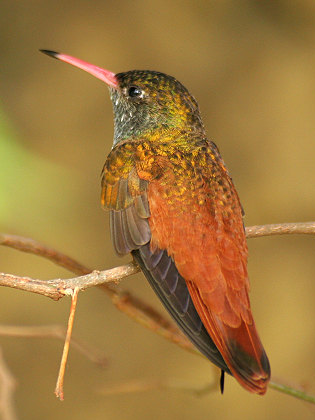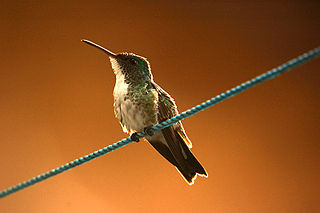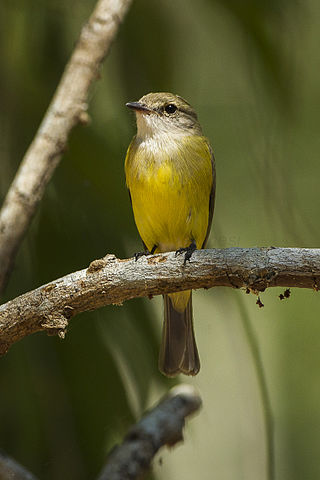
Psophodidae is a family of passerine birds native to Australia and nearby areas. It has a complicated taxonomic history and different authors vary in which birds they include in the family. In the strictest sense, it includes only the five or six species of whipbirds and wedgebills, but some authors also include the quail-thrushes (Cinclosoma), eight species of ground-dwelling birds found in Australia and New Guinea, and the jewel-babblers (Ptilorrhoa), three or four species found in rainforest in New Guinea. Others place them in their own family, the Cinclosomatidae. The Malaysian rail-babbler was formerly sometimes placed in this family, which would then be called Eupetidae.

The white-throated treecreeper is an Australian treecreeper found in the forests of eastern Australia. It is unrelated to the northern hemisphere treecreepers. It is a small passerine bird with predominantly brown and white plumage and measuring some 15 cm (6 in) long on average. It is insectivorous, eating mainly ants. Unlike treecreepers of the genus Climacteris, the white-throated treecreeper does not engage in cooperative breeding, and wherever it overlaps with species of that genus, it feeds upon much looser bark besides typically using different trees.

Threatened fauna of Australia are those species and subspecies of birds, fish, frogs, insects, mammals, molluscs, crustaceans, and reptiles to be found in Australia that are in danger of becoming extinct. This article lists species classified as threatened species under the Commonwealth Environment Protection and Biodiversity Conservation Act 1999.

The pied butcherbird is a songbird native to Australia. Described by John Gould in 1837, it is a black and white bird 28 to 32 cm long with a long hooked bill. Its head and throat are black, making a distinctive hood; the mantle and much of the tail and wings are also black. The neck, underparts and outer wing feathers are white. The juvenile and immature birds are predominantly brown and white. As they mature their brown feathers are replaced by black feathers. There are two recognised subspecies of pied butcherbird.

The eastern whipbird is an insectivorous passerine bird native to the east coast of Australia. Its whip-crack song is a familiar sound in forests of eastern Australia. Two subspecies are recognised. Heard much more often than seen, it is dark olive-green and black in colour with a distinctive white cheek patch and a crest. The male and female are similar in plumage.

The amazilia hummingbird is a hummingbird in the "emeralds", tribe Trochilini of subfamily Trochilinae. It is the only species placed in the genus Amazilis. It is found in Ecuador and Peru. Its six subspecies differ primarily in their throat and belly colors.

The red-lored whistler is one of nine species of whistler occurring in Australia and a member of the family Pachycephalidae which includes whistlers, shrike-thrushes, pitohuis and allies. The limited range of this endemic bird of the Mallee woodland in one small area in New South Wales and another, larger area encompassing north-western Victoria and adjacent South Australia has seen it listed nationally as vulnerable.

The black-throated whipbird is a passerine bird found in several scattered populations in Southwest Australia. It is predominantly olive green in colour. It was formerly considered to be conspecific with the white-bellied whipbird, so shares the common name "western whipbird".

Whipbirds and wedgebills are collectively recognised in the genus Psophodes. Wedgebills are divided into the chirruping wedgebill and the chiming wedgebill. Whipbirds are divided into the eastern whipbird and the western whipbird. Subspecies of the western whipbird residing in Western Australia are known to be endangered. Psophodes is a genus of five species of songbirds endemic to Australia, known as whipbirds and wedgebills.

The plain-bellied emerald is a species of hummingbird in the "emeralds", tribe Trochilini of subfamily Trochilinae. It is found in Brazil, the Guianas, and Venezuela.

The glittering-bellied emerald is a species of hummingbird in the "emeralds", tribe Trochilini of subfamily Trochilinae. It is found in Argentina, Bolivia, Brazil, Paraguay, and Uruguay.

The white-bellied parrot, or white-bellied caique in aviculture, is a species of bird in the subfamily Arinae of the family Psittacidae, the African and New World parrots. It is found in Bolivia, Brazil, Colombia, and Peru.

Gerygone, the gerygones or peep-warblers, is a genus of bird in the family Acanthizidae. The genus ranges from Southeast Asia through New Guinea and Australia to New Zealand and the Chatham Islands. Most of the species are found in Australia and New Guinea; only one, the golden-bellied gerygone, has managed to cross Wallace's Line and colonise as far as Thailand, Malaysia and the Philippines.

The lemon-bellied flyrobin or lemon-bellied flycatcher is a species of bird in the family Petroicidae. Found in Australia, Indonesia, and Papua New Guinea, its natural habitats are subtropical or tropical moist lowland forests and subtropical or tropical mangrove forests.

The mallee emu-wren is a species of bird in the Australasian wren family, Maluridae. It is endemic to Australia.

Peebinga Conservation Park is a 34 km2 protected area lying 40 km north of the town of Pinnaroo in the Murray Mallee region of south-eastern South Australia, about 240 km east of Adelaide and 10 km west of the Victorian border.

The black-legged parrot, also known as the western white-bellied parrot, is a bird in subfamily Arinae of the family Psittacidae, the African and New World parrots. It is found in Bolivia, Brazil, and Peru. The South American Classification Committee of the American Ornithological Society, the International Ornithological Committee, and the Clements taxonomy treat the black-legged parrot as a subspecies of the white-bellied parrot. BirdLife International's Handbook of the Birds of the World (HBW) considers it a full species.

Lalage is a genus of passerine birds belonging to the cuckooshrike family Campephagidae, many of which are commonly known as trillers. There are about 18 species which occur in southern Asia and Australasia with a number of species on Pacific islands. They feed mainly on insects and fruit. They build a neat cup-shaped nest high in a tree.
Western whipbird may refer to the following bird species and subspecies:
















